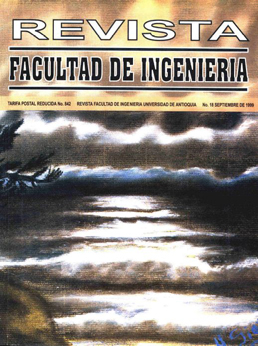Remoción y recuperación de metales pesados de aguas residuales industriales
DOI:
https://doi.org/10.17533/udea.redin.325814Keywords:
Flying ash, adsorbents, ion exchange, heavy metals, zeolites.Abstract
En el siguiente trabajo se presenta el estado del arte sobre los diferentes métodos y tecnologías para la remoción y recuperación de metales pesados que actualmente se están utilizando para la descontaminación y control de las aguas residuales industriales. Además, se presenta una alternativa para la remoción de Cr(III) y Cr(VI), empleando como adsorbente un material sólido de desecho, con resultados satisfactorios, lo que hace que esta propuesta se circunscriba dentro del programa de tecnologías limpias y bolsa de residuos.Downloads
References
PETRUZELLI, Dominico et-al. "Ion exchange process for chromium removal and recovery from tannery wastes". Ind. Eng. Chem. Res. Vol. 34, 1995, pp. 2612-2617. DOI: https://doi.org/10.1021/ie00047a009
CADENA, F. et-al. 47 th Purdue industrial waste conference proceedings. Michigan, USA. 1992, p.699.
ARRIAGADA, R. et-al. Informe FONDECYT, Chile, No. 195.0771
SON Kou et-al. Ciencia y Tecnología para el Desarrollo (CYTED) 1998. p.241
SLA VEE and PECKERING. Ciencia y Tecnologia para el Desarrollo (CYTED) 1998. P.198
BARNES, M. et-al. Wastewater. Vol. 35, 1990. p.446. DOI: https://doi.org/10.1037/028579
O'DWYER, T. F. et-al. "Recovery of chromium from tannery efluents using a redox-adsortion approach". J. Chem. Techn. Biotechnol. Vol. 62, 1995, p.30. DOI: https://doi.org/10.1002/jctb.280620105
SAAD, A.K. et-al. "Adsortion of chromium (III), chromium (VI) and silver (l) on bentonita". Waste Management, Vol. 15 No.4, 1995. p.271. DOI: https://doi.org/10.1016/0956-053X(95)00025-U
MALLIOU, E. et-al. ''Uptake of lead and cadmium by clinoptilolita". The science of the total environment, Vol. 149, 1994, p. 139. DOI: https://doi.org/10.1016/0048-9697(94)90174-0
PÉREZ CANDELA, Manuel et-al. "Chromium (VI) removal with activated carbons". Water Res., Vol. 29, No. 9, 1995, p. 2174. DOI: https://doi.org/10.1016/0043-1354(95)00035-J
MUTHUKUMURA, K. et-al. "Removal and recovery of chromium from plating waste using chemically activates carbon". Metal Finisching, november 1995, p.46. DOI: https://doi.org/10.1016/S0026-0576(05)80049-2
SAYED, S.A. "Exchange of Zn+2, V+2, Cd+2 and Hg+2, using zeolites and dinonylnaphalene-sulfonate". Zealite, Vol. 17, 1996, p. 261. DOI: https://doi.org/10.1016/0144-2449(96)00040-1
CHENG-F ANG, Lin; HSING-CHENG His .. "Resource recovery of waste fly ash synthesis of zeolite-like materials". Enviran. Sci. Technol., Vol. 29, 1995, p. 1109. DOI: https://doi.org/10.1021/es00004a033
SINGER, Arieh and BERKGAUT Vadim, "Cation exchange properties of hidrotermally treated coal fly ash". Enviran. Sci. Technol., vol. 29, 1995 pp. 1748-1753. DOI: https://doi.org/10.1021/es00007a009
AMRHEIN, Christopher; et-al. "Synthesis and propierties of zeolites from coal fly ash". Environ. Sci. Technol., Vol 30, No. 3, 1996, p. 735. DOI: https://doi.org/10.1021/es940482c
PERRY, Jhon H, "Chemical Engineers Handbook",Mcgraw-Hill Company, New York, fourth edition, pag. 2- 77, 1963.
APHA, A WWA, WPCF, "Standard Methods, for the examination of water and wastewater".1989
GIL PAVAS, Edison H. "Remoción de cromo de la industria de curtiembres utilizando mallas moleculares". Tesis de Maestría, Universidad Nacional de Colombia, Ingeniería Química, Santafé de Bogotá. (1997).
HAWASH, S.; FARAH, J. Y. "Investigation of nickel ion removal by means of activated e lay". Adsortion Science and Technology, Vol. 9, 1994, p. 254.
Downloads
Published
How to Cite
Issue
Section
License
Revista Facultad de Ingeniería, Universidad de Antioquia is licensed under the Creative Commons Attribution BY-NC-SA 4.0 license. https://creativecommons.org/licenses/by-nc-sa/4.0/deed.en
You are free to:
Share — copy and redistribute the material in any medium or format
Adapt — remix, transform, and build upon the material
Under the following terms:
Attribution — You must give appropriate credit, provide a link to the license, and indicate if changes were made. You may do so in any reasonable manner, but not in any way that suggests the licensor endorses you or your use.
NonCommercial — You may not use the material for commercial purposes.
ShareAlike — If you remix, transform, or build upon the material, you must distribute your contributions under the same license as the original.
The material published in the journal can be distributed, copied and exhibited by third parties if the respective credits are given to the journal. No commercial benefit can be obtained and derivative works must be under the same license terms as the original work.










 Twitter
Twitter